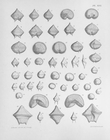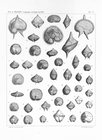
| Introduction | | Search taxa | | Taxon tree | | Taxon match | | Checklist | | Literature | | Stats | | Photogallery | | OBIS Vocab | | Log in |
CaRMS name detailsPeridinium ovatum (Pouchet) F.Schütt, 1895
156527 (urn:lsid:marinespecies.org:taxname:156527)
unaccepted (Synonym)
Species
marine
(of Protoperidinium ovatum Pouchet, 1883) Pouchet, G. (1883). Contribution a l'histoire des Cilio-Flagelles. Journal de l'Anatomie et de la Physiologie Normales et Pathologiques de l'Homme et des Animaux, 19: 399-455. [details]
Guiry, M.D. & Guiry, G.M. (2021). AlgaeBase. World-wide electronic publication, National University of Ireland, Galway (taxonomic information republished from AlgaeBase with permission of M.D. Guiry). Peridinium ovatum (Pouchet) F.Schütt, 1895. Accessed through: Kennedy, M.K., L. Van Guelpen, G. Pohle, L. Bajona (Eds.) (2021) Canadian Register of Marine Species at: http://marinespecies.org/carms/aphia.php?p=taxdetails&id=156527 on 2025-05-14
Nozères, C., Kennedy, M.K. (Eds.) (2025). Canadian Register of Marine Species. Peridinium ovatum (Pouchet) F.Schütt, 1895. Accessed at: https://marinespecies.org/carms/aphia.php?p=taxdetails&id=156527 on 2025-05-14
Date action by 2015-06-26 12:00:51Z changed db_admin
original description
(of Protoperidinium ovatum Pouchet, 1883) Pouchet, G. (1883). Contribution a l'histoire des Cilio-Flagelles. Journal de l'Anatomie et de la Physiologie Normales et Pathologiques de l'Homme et des Animaux, 19: 399-455. [details]
basis of record Guiry, M.D. & Guiry, G.M. (2025). AlgaeBase. <em>World-wide electronic publication, National University of Ireland, Galway.</em> searched on YYYY-MM-DD., available online at http://www.algaebase.org [details] basis of record Muller, Y. (2004). Faune et flore du littoral du Nord, du Pas-de-Calais et de la Belgique: inventaire. [Coastal fauna and flora of the Nord, Pas-de-Calais and Belgium: inventory]. <em>Commission Régionale de Biologie Région Nord Pas-de-Calais: France.</em> 307 pp., available online at http://www.vliz.be/imisdocs/publications/145561.pdf [details] additional source Meunier, A. (1919). Microplankton de la Mer Flamande: 3. Les Péridiniens. Mémoires du Musée Royal d'Histoire Naturelle de Belgique = Verhandelingen van het Koninklijk Natuurhistorisch Museum van België, VIII(1). Hayez, imprimeur de l'Académie royale de Belgique: Bruxelles. 111, 7 plates pp. (look up in IMIS) [details] additional source Meunier, A. (1910). Microplankton des Mers de Barents et de Kara. Duc d'Orléans. Campagne arctique de 1907. Imprimerie scientifique Charles Bulens: Bruxelles, Belgium. 355 + atlas (XXXVII plates) pp. (look up in IMIS) [details] additional source Balech, E. (1959). Operación oceanográfica Merluza. V Crucero. Plancton. <em>Servicio de Hidrografia Naval.</em> 618: 1-43. [details] Available for editors additional source Guiry, M.D. & Guiry, G.M. (2025). AlgaeBase. <em>World-wide electronic publication, National University of Ireland, Galway.</em> searched on YYYY-MM-DD., available online at http://www.algaebase.org [details]  Present Present  Inaccurate Inaccurate  Introduced: alien Introduced: alien  Containing type locality Containing type locality
Unreviewed
Diet general for group: both heterotrophic (eat other organisms) and autotrophic (photosynthetic) [details]Habitat pelagic [details] Importance General: known for producing dangerous toxins, particularly when in large numbers, called "red tides" because the cells are so abundant they make water change color. Also they can produce non-fatal or fatal amounts of toxins in predators (particularly shellfish) that may be eaten by humans. [details] Predators marine microorganisms and animal larvae [details] Reproduction general for group: both sexual and asexual [details] |


